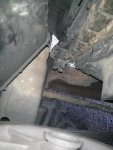Jason30
New Member
- Joined
- Mar 18, 2014
- Messages
- 1
- Transmission
- Automatic
Hey all. New to the forum. Any advice or help you all can give me will be very appreciated. I'm not very repair savvy and have some questions about flushing the radiator. It's been sitting for a while and inside the radiator is full of sludge and rust. At first I thought the head gasket was blown or cracked so I picked up the chemical test block but the test passed.
First question, is the attached picture the petcock valve? And if so how exactly should I flush the radiator. I've been reading a lot and want to be very thorough so I don't mess anything up.
Should the steps go....Turn on car, turn on heater until it heats up then turn off, open radiator cap, open peacock, let drain fully (or do I leave car and heat on while it's draining?) Then turn car back on, turn heater on, put in coolant flush fluid with water, open radiator cap, turn petcock, let it drain...then fill back up with 50/50 while car is running with heater on?
I'm just a bit confused as to when the car and heater should be on during the flush. If anyone has a step by step in detail that would be great! Thanks for reading and I look forward to being an active member now that I'm a Ranger owner!
First question, is the attached picture the petcock valve? And if so how exactly should I flush the radiator. I've been reading a lot and want to be very thorough so I don't mess anything up.
Should the steps go....Turn on car, turn on heater until it heats up then turn off, open radiator cap, open peacock, let drain fully (or do I leave car and heat on while it's draining?) Then turn car back on, turn heater on, put in coolant flush fluid with water, open radiator cap, turn petcock, let it drain...then fill back up with 50/50 while car is running with heater on?
I'm just a bit confused as to when the car and heater should be on during the flush. If anyone has a step by step in detail that would be great! Thanks for reading and I look forward to being an active member now that I'm a Ranger owner!













